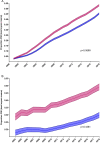Sex differences over time for glycemic control, pump use and insulin dose in patients aged 10-40 years with type 1 diabetes: a diabetes registry study
- PMID: 34969693
- PMCID: PMC8718474
- DOI: 10.1136/bmjdrc-2021-002494
Sex differences over time for glycemic control, pump use and insulin dose in patients aged 10-40 years with type 1 diabetes: a diabetes registry study
Abstract
Introduction: To evaluate sex differences in people with type 1 diabetes concerning changes in glycemic control and trends in insulin pump use and insulin dose over two decades in adolescents and one-and-a-half decades in adults.
Research design and methods: People aged 10-20 years (data years 1999-2018) and 21-40 years (data years 2004-2018) with type 1 diabetes were identified in the Diabetes Prospective Follow-up Registry (DPV). All available patients' data sets of the respective period were used for linear regression analyses to investigate trends in HbA1c, pump use, insulin doses and body mass index SD scores (BMI-SDS) in females and males. In addition, stratification by migrant background was made for the adolescent group.
Results: In the youth group (n=68 662), both boys and girls showed an HbA1c decrease over the period examined. After stratification for migrant background, an HbA1c convergence between boys and girls was seen in those without migrant background as of 2016. Usage of insulin pumps increased continuously from 3% (boys and girls) to 47% (boys) and 54% (girls), respectively. The daily insulin dose in units per kilogram body weight and day increased continuously from 1999 to 2018. An insulin dose leveling between boys and girls occurred. BMI-SDS consistently increased in girls whereas only slight variations were observed in boys.The adult group (n=15 380) showed constant HbA1c sex differences from 2004 to 2018 with lower HbA1c level in females. The use of insulin pump therapy rose from 18% to 35% (males) and 30% to 50% (females).
Conclusions: The gap in metabolic control between boys and girls with type 1 diabetes seems to close, but predominantly in adolescents without a migrant background. Improved HbA1c was associated with increased insulin pump use, especially in girls.In adult patients, sex differences in metabolic control and insulin pump use persist: women show constantly lower HbA1c values and higher insulin pump use.
Keywords: adolescent medicine; adult; insulin; sex characteristics.
© Author(s) (or their employer(s)) 2021. Re-use permitted under CC BY-NC. No commercial re-use. See rights and permissions. Published by BMJ.
Conflict of interest statement
Competing interests: None declared.
Figures




References
Publication types
MeSH terms
Substances
LinkOut - more resources
Full Text Sources
Medical
Miscellaneous
